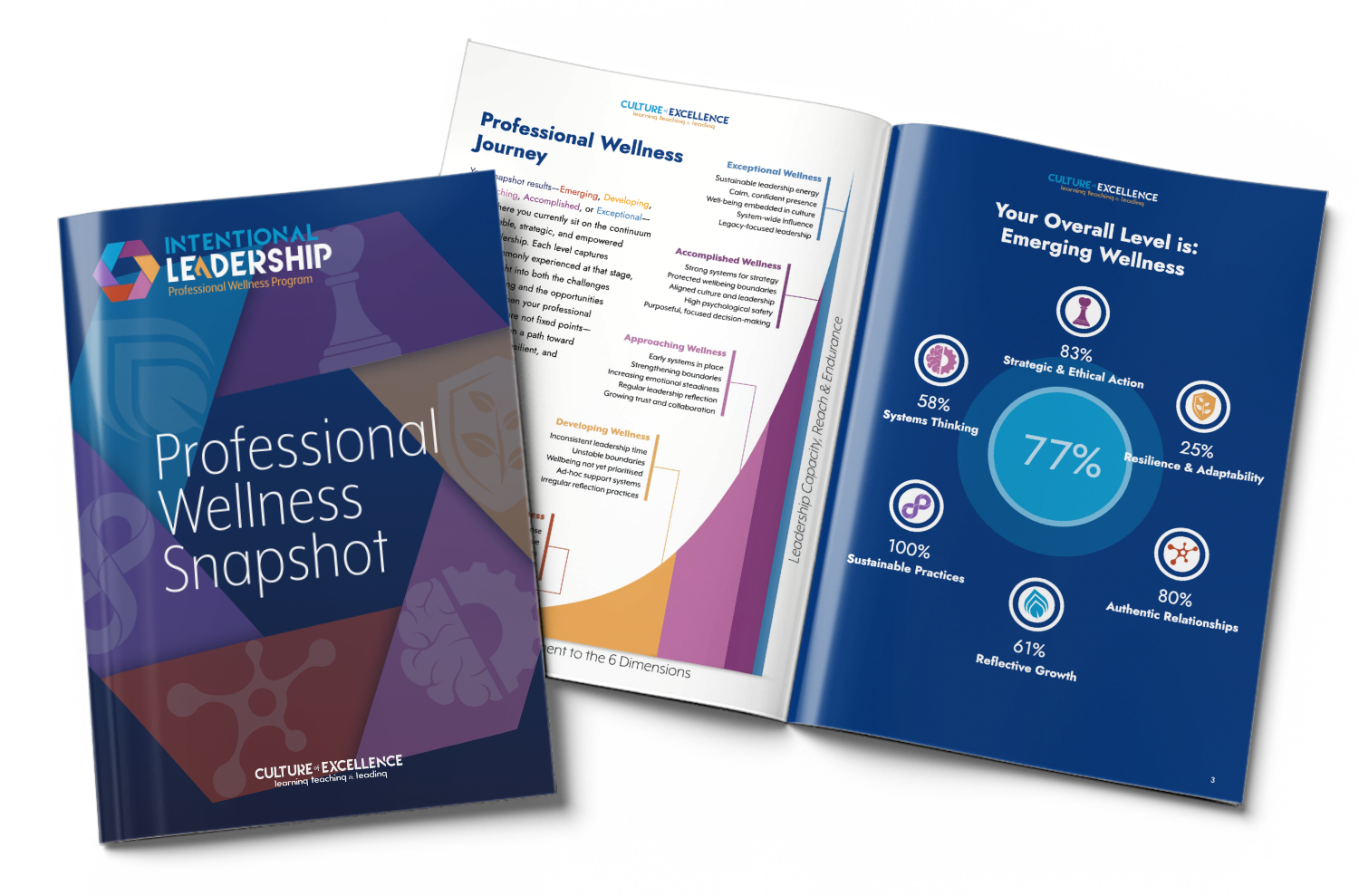
The Feedback Vacuum
Why silence isn’t support—and never was
This video focuses on something most school leaders feel, but almost none will admit out loud—that they’re not getting the feedback they need. That silence creates doubt; not because they’ve failed, but because they no longer know if they’re still on track. And the higher they rise? The fewer mirrors they have.
What’s one piece of feedback that changed how you lead?
Want to Lead With Steadiness—Not Strain?
Join our FREE Professional Wellness Workshop—a live session where we explore all six dimensions and help you refocus on what really sustains school leadership.

The Feedback Vacuum
Why silence isn’t support—and never was
For many school leaders, silence isn’t just part of the job—it becomes the job. You lead, you resolve, you stay visible, and you give feedback constantly to others. But when it comes to receiving feedback yourself, the system offers very little in return. And at first, it doesn’t feel like a problem, until it does.
Because what appears to be calm and self-direction often masks a slow, quiet erosion—one where leaders begin to second-guess their own judgment, not from failure, but from isolation. You see, feedback isn’t a bonus—it’s oxygen. Without it, good leaders suffocate quietly.
In the video above, we explore what happens when leadership becomes a solo loop, with no mirrors and no meaningful input—just performance without calibration. This experience, I argue, isn’t a side effect of school leadership—it’s becoming a defining feature. And it’s doing serious damage.
Why school leaders are leading without mirrors
The absence of feedback isn’t just an interpersonal issue—it’s structural. In systems where principals are expected to “just handle things,” formal feedback mechanisms often disappear after the first few years. Informal feedback from supervisors is rare. Peer feedback is unstructured. And upward feedback from staff? Risky, political, and often filtered through fear.
The result is a culture of silence—one where leaders stop expecting feedback because they’ve learned not to rely on it.
Feedback isn’t a bonus—it’s oxygen. Without it, good leaders suffocate quietly.
Research from the Australian Institute for Teaching and School Leadership (AITSL, 2014) stresses the importance of reflective practice and professional dialogue in leadership. But most principals I work with admit they haven’t had a meaningful performance conversation in years. This kind of vacuum doesn’t create freedom—it breeds guesswork. And over time, guesswork leads to doubt.
Silence feels like safety—but becomes self-doubt
One of the most harmful patterns I’ve seen is this: a leader interprets silence as approval. It makes sense—in a busy school environment, “no news” feels like good news. But as weeks turn into months, and months into years, that silence starts to weigh heavier. You begin to wonder:
- Am I still on track?
- Am I leading well—or just not causing problems?
- Has my leadership plateaued without me noticing?
This state of quiet uncertainty is what I call the feedback vacuum—a condition where feedback doesn’t flow because the system hasn’t made space for it. And just like any vacuum, it creates pressure, which eventually turns inward.
Feedback arrives too late, and too loud
When feedback finally does arrive in these environments, it often shows up during moments of tension:
- A parent complaint that escalates
- A system-level directive following poor student results
- A staff member raising an issue in frustration
In these moments, feedback is no longer about learning—it becomes about correction.
When feedback only comes after a crisis, it’s not growth—it’s damage control.
Leaders who only experience feedback as fallout begin to fear it. Even constructive comments feel like criticism. Even neutral observations feel like accusations. This feedback aversion isn’t weakness—it’s conditioning. And it leads to an increasingly fragile sense of confidence, even in highly experienced leaders.
If this feels connected to the issues we raised in Glorifying Overwork, you’re right—the emotional labour of leadership is cumulative, and silence doesn’t protect against burnout—it accelerates it.
When growth becomes guesswork, leadership contracts
The longer a leader goes without feedback, the harder it becomes to maintain clarity. Not just clarity of performance, but clarity of identity.
You stop testing new ideas and default to what’s safe. You over-explain yourself, and you lose your edge—not because you’ve done anything wrong, but because you’ve been leading without confirmation for too long. One leader described it to me this way: “I’m not leading with confidence anymore—I’m leading with caution.”
That shift is subtle, but critical. It marks the difference between proactive leadership and reactive survival. And it’s exactly the kind of erosion that shows up under the barrier we call the Emotional Tsunami—the overwhelming undercurrent of doubt, depletion, and emotional withdrawal that affects even the most committed leaders.
Feedback isn’t performance—it’s wellness
Here’s the real shift: feedback is not a performance issue—it’s a wellness issue. In the Professional Wellness Program, we map all leadership resilience to six measurable Dimensions of Professional Wellness. This challenge—navigating the feedback vacuum—cuts across two of the most essential dimensions:
Reflective Growth
This dimension speaks directly to your internal leadership dialogue:
- Are you stopping to review?
- Are you noticing patterns?
- Are you making time to track not just what you do—but how you’re developing?
Structured reflection is essential. It doesn’t have to be elaborate. It just has to be intentional.
If this dimension is under strain, you’ll likely feel stuck, unsure, or autopiloting through the term without clarity. The Professional Wellness Snapshot offers a free, private starting point to assess this. It shows leaders how well they’re currently positioned to reflect, grow, and recalibrate.
Authentic Relationships
The second dimension is just as critical: trust. Feedback doesn’t flow where fear exists. It requires:
- Psychological safety
- Relational permission
- A shared culture of growth
This isn’t about being “nice” or encouraging warm fuzzies. It’s about building relationships where challenge is welcome because it’s trusted. If people aren’t giving you feedback, the question isn’t, "Why are they withholding it?" Instead, we should be asking, "Have we built the permission to speak honestly?”
Too many leaders are navigating their most complex challenges alone—not because no one cares, but because no one knows how to offer the feedback that would actually help. That’s not sustainable, and it’s absolutely something we can fix.
Creating your own feedback system
If your system isn’t giving you feedback, it’s time to stop waiting and start building. That might look like:
- Setting up peer feedback check-ins once a term
- Inviting staff reflections after major initiatives
- Using a journaling structure tied to the six wellness dimensions
- Having one trusted colleague who debriefs leadership moments with you regularly
This is what it means to lead reflectively instead of reactively.
And for those working through topics like Shackled Authority, you’ll see just how essential relational trust is—not just for others to thrive under your leadership, but for you to stay grounded in it.
Final Thoughts: Start with the mirror
There’s no shame in seeking feedback. The shame is in a system that teaches leaders to survive without it. So here’s what I’ll leave you with:
You cannot lead well in a vacuum. Leadership is a reflective craft. It requires mirrors. Start by building one.
The silence won’t fix itself. But you can.
References
Australian Institute for Teaching and School Leadership. (2014). Australian Professional Standard for Principals and the Leadership Profiles.
Robinson, V. M. J., Lloyd, C. A., & Rowe, K. J. (2008). The impact of leadership on student outcomes: An analysis of the differential effects of leadership types. Educational Administration Quarterly, 44(5), 635–674. https://doi.org/10.1177/0013161X08321509

Not Sure What's Holding You Back?
Take our quick 2-minute Professional Wellness Snapshot to pinpoint where your biggest barrier lies—and which leadership dimension to strengthen next.